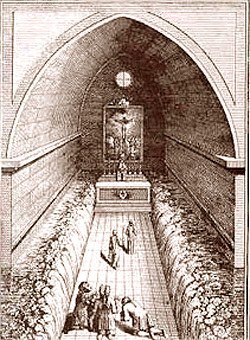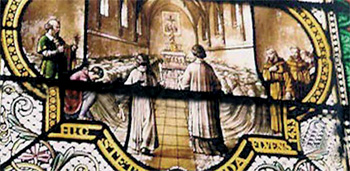 |
 |
Stories & Legends
The Eucharistic Miracle of Avignon
Hugh O’Reilly
The Confraternity of the Grey Penitents of Avignon, whose founder was Louis VIII, the father of St. Louis, has its seat in the Chapel of the Holy Cross in that city. The Holy Eucharist has been exposed there continuously day and night since September 14, 1226.

A depiction of the supernatural wonder |
The city of Avignon is situated a short distance from the intersection of the Rhone and Durance Rivers. One of the tributaries, the small Sorgue River, passes through the city and would periodically overflow in the lower parts of the city.
On November 30, 1433, torrential rains caused the Sorgue to overflow much more than usual. The water level rose to an alarming height and entered the Chapel of the Grey Penitents. The flood was so great that the Franciscan Superiors of the Order feared that the waters had reached the altar and covered the monstrance where the Holy Eucharist was exposed.
The next morning, two superiors went in a boat and rowed their way to the Chapel. After opening the doors, they were astounded to find that the waters – similar to what had happened with the parting of the Red Sea and the Jordan – were standing on either side of the central aisle like two great walls, leaving the passage that led from the door to the altar absolutely free and dry.
The miracle was considered still greater when they reached the altar - which was at the same level as the pews, without steps - and realized that everything around it was equally dry. The waters – which had risen to a height of over six feet inside the church – stood like two walls around the altar, forming arches. This is what is reported in the document of the Confraternity register, which is still conserved to this day.

A stain glass window in the Chapel commemorates the miracle |
After the Superiors knelt to adore and thank the Author of such a great miracle, they hurried to tell the news to the other members of the Order. Twelve of them came and witnessed the wonder. They then sent for four friars of the Franciscan Order who were Doctors in Theology, who also saw the marvel and confirmed it.
Every year on the 30th of November, the feast day of St. Andrew, this great miracle is commemorated in the Chapel. All the members of the Confraternity of the Grey Penitents assist at the morning Mass and receive Communion, going on their knees up the sacred aisle that had been miraculously preserved from the waters. In the evening the preacher reminds the congregation of the miracle, and the song Cantemus Domino [Let us sing to the Lord] sung by Moses after the passage through the Red Sea is intoned before the blessing with the Blessed Sacrament.

Based upon and translated from
Vie des Saints, Paris: Bonne Presse
Posted May 22, 2009


Related Topics of Interest
 St. Louis IX, King of France St. Louis IX, King of France
 The Rooster of Barcelos The Rooster of Barcelos
 The Tumbler of Our Lady The Tumbler of Our Lady
 Ranulf of Chester Ranulf of Chester
 The Man Who Sold His Soul to the Devil The Man Who Sold His Soul to the Devil
 The Miracle of Ourique and the Birth of Portugal The Miracle of Ourique and the Birth of Portugal
 Translation of the Holy House to Loreto Translation of the Holy House to Loreto


|
Legends | Religious |
Home | Books | CDs | Search | Contact Us | Donate

© 2002-
Tradition in Action, Inc. All Rights Reserved
|
 |
|